The Union Budget 2024-25 reaffirms its commitment to empowering citizens, especially the poor and marginalized. Building on the foundation laid since 2014, this budget focuses on strengthening the abilities of all Indians to seize opportunities in the journey towards a ‘Viksit Bharat’ (Developed India).
This year’s budget demonstrates a strong resolve to boost employment, enhance skilling initiatives, support MSMEs, and uplift the middle class. Furthermore, it also outlines nine key priorities that encompass critical areas from agriculture to next-generation reforms. These priorities reflect a holistic approach to development, ensuring that growth is inclusive and sustainable.
As India moves towards its goal of becoming a developed nation by 2047, Priority 3 of the union budget focuses on “Inclusive Human Resource Development and Social Justice,” outlining several key initiatives aimed at uplifting marginalized communities and promoting balanced regional development.
Saturation Approach and Empowerment Initiatives
The government emphasizes a saturation approach to ensure all eligible individuals benefit from developmental programs. This approach aims to enhance capabilities and empower people through targeted interventions in education, health, and skill development. Programs like PM Vishwakarma, PM SVANidhi, National Livelihood Missions, and Stand-Up India are being intensified to support economic activities among craftsmen, artisans, self-help groups, Scheduled Castes, Scheduled Tribes, women entrepreneurs, and street vendors.
- PM Vishwakarma[1]: As of July 2024, the PM Vishwakarma Yojana continues to make significant strides in uplifting artisans and craftspeople across India. A total of 5,03,161 candidates have been certified after completing basic training nationwide, with 46,726 artisans certified specifically in Andhra Pradesh.[2]

![]()
- PM SVANidhi[4]: The PM Street Vendor’s AtmaNirbharNidhi (PM SVANidhi) scheme, launched on June 1, 2020, is a pivotal central sector initiative aimed at supporting urban street vendors in India. The scheme provides collateral-free working capital loans, initially up to ₹80,000, incentivizing regular repayment with a 7% interest subsidy and offering cashback up to ₹1,200 per year for digital transactions. It extends its benefits not only to urban areas but also to vendors from surrounding rural and peri-urban areas, facilitating inclusive growth. The scheme utilizes Aadhaar-based e-KYC for streamlined processes and employs an end-to-end IT platform with SMS-based notifications for real-time application status updates. All lending institutions, including NBFCs/MFIs and DPAs, are actively encouraged to participate, contributing to efforts aimed at alleviating urban poverty in India.
As of July 17, 2024[5], the PM SVANidhi scheme has disbursed more than 86 lakh loans, totaling over ₹11,680 crores, benefiting nearly 65 lakh street vendors nationwide.
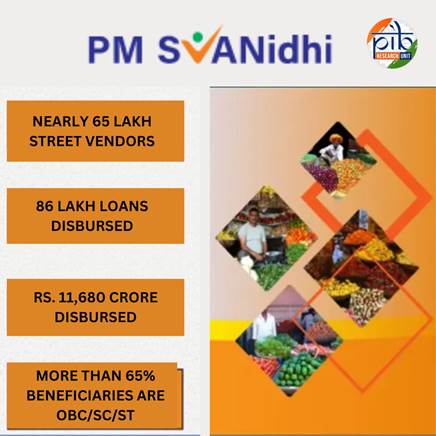
- Deendayal Antyodaya Yojana- National Rural Livelihood Mission (DAY-NRLM)[6] aims to alleviate rural poverty by organizing households into self-help groups (SHGs), facilitating access to credit, promoting skill development, and empowering women [7]through sustainable livelihood initiatives across India.

Stand-Up India[8]: Stand up India Scheme was launched on April 05, 2016 to promote entrepreneurship at grassroot level focusing on economic empowerment and job creation. The scheme has been extended till 2025.
Purvodaya: Development of the Eastern Region
The eastern states of Bihar, Jharkhand, West Bengal, Odisha, and Andhra Pradesh are rich in resources and cultural heritage. The Purvodaya initiative aims to transform this region into a growth engine for the nation through:
Industrial Development
The Amritsar Kolkata Industrial Corridor will include the development of an industrial node at Gaya. This initiative aims to blend cultural heritage with modern economic growth, showcasing the model of “Vikas bhi Virasat bhi” (Development along with Heritage).
Road Connectivity Projects
Several road connectivity projects will be undertaken to improve infrastructure and facilitate economic activities in the region, including:
- Patna-Purnea Expressway
- Buxar-Bhagalpur Expressway
- Bodhgaya, Rajgir, Vaishali, and Darbhanga Spurs
- Additional 2-lane bridge over River Ganga at Buxar
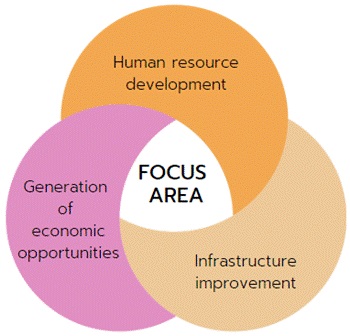
Power and Infrastructure Projects
Significant investments will be made in power projects, including a new 2400 MW power plant at Pirpainti. Additional infrastructure projects include new airports, medical colleges, and sports facilities in Bihar.

Andhra Pradesh Reorganization Act
The government remains committed to fulfilling the commitments made under the Andhra Pradesh Reorganization Act. Key initiatives include: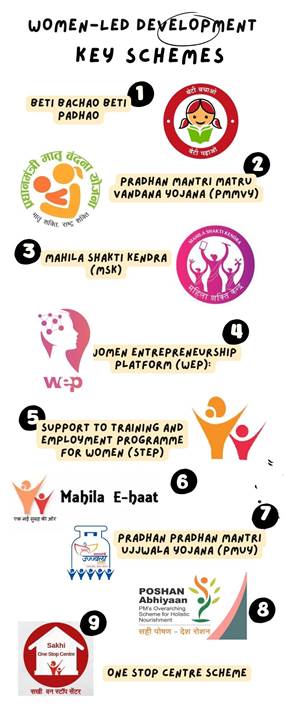
- Special financial support for capital development through multilateral development agencies (₹15,000 crore in the current financial year)
- Polavaram Irrigation Project: Ensuring the timely completion of this vital project to support the state’s farmers and enhance food security.
- Investments in infrastructure for Kopparthy node on the Visakhapatnam-Chennai Industrial Corridor and Orvakal node on the Hyderabad-Bengaluru Industrial Corridor.
- Grants for backward regions of Rayalaseema, Prakasam, and North Coastal Andhra.
PM Awas Yojana: Housing for All
The government has announced the construction of three crore additional houses under the PM Awas Yojana, both in rural and urban areas. Necessary allocations have been made to ensure the successful implementation of this ambitious housing scheme.
Women-Led Development
A significant allocation of over ₹3 lakh crore for schemes benefiting women and girls underscores the government’s commitment to enhancing women’s role in economic development.
Pradhan Mantri Janjatiya Unnat Gram Abhiyan
To improve the socio-economic conditions of tribal communities, the government will launch the Pradhan Mantri Janjatiya Unnat Gram Abhiyan. This initiative will adopt:
- Saturation coverage for tribal families in tribal-majority villages and aspirational districts.
- Coverage of 63,000 villages
- Benefiting 5 crore tribal people.

Expansion of Banking Services in the North-East
The budget proposes setting up more than 100 branches of India Post Payment Bank[9] in the North-East region to expand banking services. This expansion aims to provide accessible, affordable, and trusted banking services to the underserved and unbanked populations.
This initiative supports the vision of a Digital India, promoting a less cash economy and empowering citizens through secure and intuitive banking solutions available in multiple languages.
Rural Development and Infrastructure
The budget provides an allocation of ₹2.66 lakh crore for rural development, including rural infrastructure projects. This allocation aims to enhance the quality of life in rural areas through improved connectivity, healthcare, education, and economic opportunities.
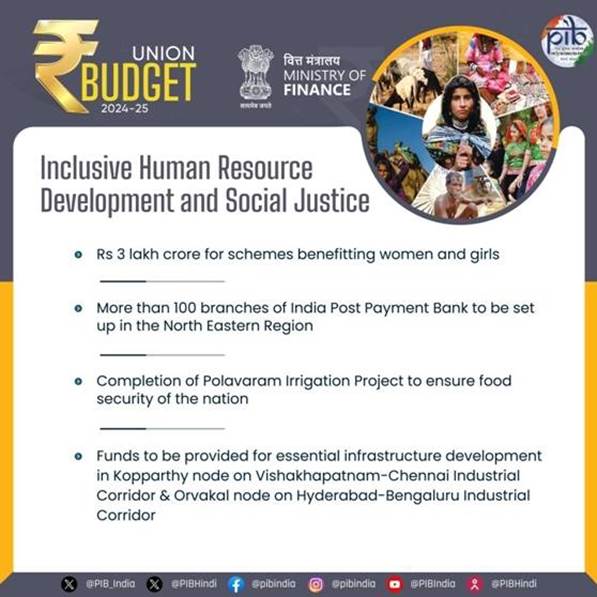
Conclusion
The Union Budget 2024-25, through its emphasis on Inclusive Development & Social Justice, epresents a comprehensive and ambitious approach to inclusive human resource development and social justice. By targeting various marginalized groups and addressing regional imbalances, the government aims to create a more equitable and prosperous society. The success of these initiatives will play a crucial role in India’s journey towards becoming a developed nation. As these programs unfold, it will be important to closely monitor their implementation and impact, making necessary adjustments to ensure they meet their intended goals of inclusive growth and social justice.

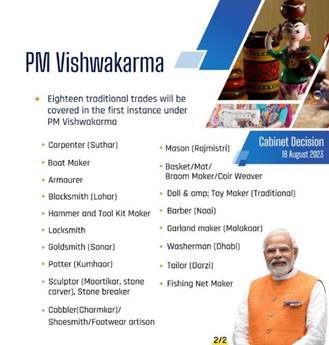

Comments are closed.